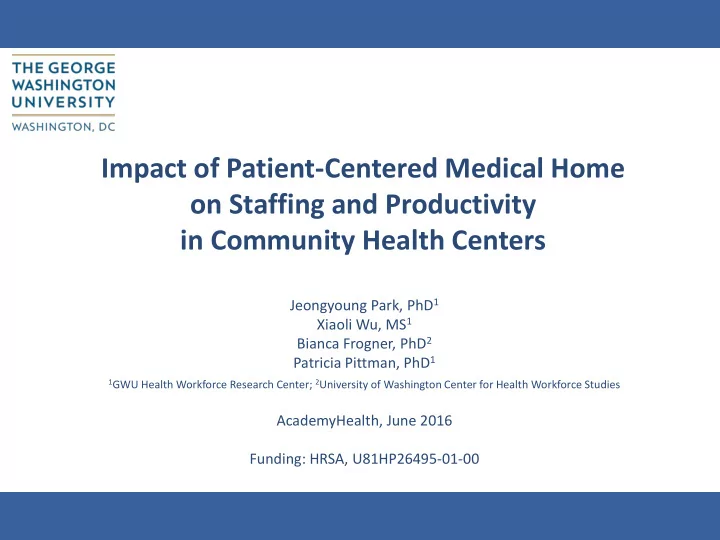

Impact of Patient-Centered Medical Home on Staffing and Productivity in Community Health Centers Jeongyoung Park, PhD 1 Xiaoli Wu, MS 1 Bianca Frogner, PhD 2 Patricia Pittman, PhD 1 1 GWU Health Workforce Research Center; 2 University of Washington Center for Health Workforce Studies AcademyHealth, June 2016 Funding: HRSA, U81HP26495-01-00
Patient-Centered Medical Home • The PCMHs put emphasis on improved access to primary care and an ongoing relationship with a primary care provider or team, with improved whole- person, comprehensive and coordinated care • Increased investment in primary care to achieve the “Triple Aim” 2
Evidence on PCMH • Growing in size and scope • Evidence underscores – Reductions in health care costs and unnecessary utilization of services – Improvement in quality of care metrics, access to primary care, and patient or clinician satisfaction 3
Gaps in Evidence/Motivation • Workforce transformation (“who does what” & “how”) associated with PCMH adoption remains limited • The relationship of PCMH adoption to practice productivity is unknown • The work to date is exclusively focused on physician/group practices 4
Community Health Centers • 1,278 grantees in 2014 • Federally funded safety-net organizations • Provide comprehensive primary care to more than 22 million underserved population 5
PCMH in CHCs • Federal and State Support – Patient-Centered Medical/Health Home Initiative (PCMHHI), HRSA, FY2010 – Federally Qualified Health Center Advanced Primary Care Practice, CMMI – State Medicaid Payment Incentive • Over 65% of CHCs, as of Dec 2015 6
Aims • To examine staffing changes associated with PCMH adoption in CHCs • To examine practice productivity changes associated with PCMH adoption in CHCs 7
Data Sources • Uniform Data System, 2007-2013 • HRSA Roster of PCMHs under PCMHHI • GWU Readiness for Meaningful Use and Health Information Technology and PCMH Recognition Survey • Area Health Resources File • State NP Scope of Practice Law 8
Study Population • 994 CHCs consistently in UDS, 2007-2013 – 244 early PCMH adopters (prior to PCMHHI) excluded • 750 CHCs identified – 450 PCMH adopters (through PCMHHI) – 300 non-adopters • 693 CHCs included – 450 PCMH adopters (through PCMHHI) – 243 1 to 1 propensity-score matched non-adopters 9
PCMH Adoption, 2007-2013 10
Analytic Approach • Difference-in-Differences (DD) Y it = α + β 1 PCMH i + β 2 Post t + β 3 (PCMH*Post) it + X it θ + ƴ i + λ t + ε it – β 3 is a DD estimator – CHC FE ( ƴ i ) and Year FE ( λ t ) – Robust standard errors clustered at CHC-level 11
PCMH Adoption • Model 1: PCMH adoption – (PCMH*Post) – An indicator of PCMH adoption in a given year • Model 2: Years after PCMH adoption – (PCMH*Post 1,2,3+ ) – Dummies to specify the years after PCMH adoption – Whether the treatment effect changes over time after treatment 12
Outcomes • Staffing, FTEs – (1) Primary care physicians – (2) Advanced practice staff (NPs, PAs, CNMs) – (3) Nurses – (4) Other medical staff (MAs, NAs, QI/IT staff, etc.) – (5) Mental health and substance abuse service staff – (6) Enabling service staff (case manager, health educators) • Productivity, # visits made by each type of staff – Except other medical staff – Medical visits (1)-(3) adjusted by case-mix complexity 13
Covariates • Patient characteristics – Age, sex, race/ethnicity, insurance, limited English proficiency, poverty • Practice characteristics – Size, grant$$, EHR adoption • Other environmental characteristics – Number of physicians, NPs, PAs in the county – State laws governing NP scope of practice 14
Staffing Changes Associated with PCMH (Model 1) 15 ***p<0.001,**p<0.01,*p<0.05
Staffing Changes Associated with PCMH (Model 2) 16 ***p<0.001,**p<0.01,*p<0.05
Productivity Changes Associated with PCMH (Model 1) 17 ***p<0.001,**p<0.01,*p<0.05
Productivity Changes Associated with PCMH (Model 2) 18 ***p<0.001,**p<0.01,*p<0.05
Productivity Changes Associated with PCMH-Related Staffing Changes • Regression of (total visits) on (PCMH*Post*6Staff) – Including other medical staff – Coef. on each interaction term represents marginal productivity of each staffing type associated with PCMH adoption • We found marginal productivity increases associated with this staffing shift – (+) significant, advanced practice staff – (+) but not significant, other medical staff 19
Summary of Key Findings • A growth in advanced practice staff, other medical staff, and enabling staff over time • A decline in primary care physicians, but not statistically significant • No significant changes/trends in either nurses or mental health/substance abuse service staff • No significant increases in total visits, but we found marginal productivity increases associated with this staffing shift 20
Limitations • Grantee-level analysis – Multiple sites, implementation is heterogeneous • The UDS data do not differentiate what roles each type of staff play – “who does what” & “how” still unknown • Our measure of productivity is narrowly defined 21
Implications • Expansion of staff to non-physicians associated with PCMH adoption • Policies are needed not only to support the increased supply of these professionals, but to ensure their optimal use within care team • Close attention to their training is critical to ensuring the quality of services they provide 22
Questions? 23
Recommend
More recommend